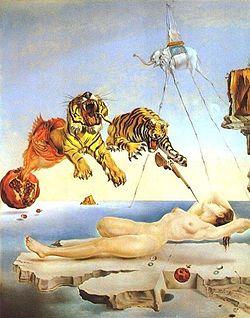Early Modern Art and WWI's Influence
Avant-Garde's art style was born from impressionism and post-impressionism predating World War I. Its primary distinction is that it does not seek to be realistic or to appeal to the viewer’s perspective, but rather focuses on how the artist experiences the world. It was the first real wave of self-expression becoming the forefront of artistic style and formatting. Fauvism, a sub-set of Avant Garde, focuses on expressive colors, awkward perspectives, and simplicity of shapes and depth. It is a stark contradiction and rejection of the values of romanticism during the previous era. All four Avant Garde styles (Fauvism, Cubism, Futurism, and Expressionist) hold many similarities but are distinguishable by minute differences in approach.
The River of Seine at Chatou by Maurice de Vlaminck is an example of a through-and-through Fauvist artwork. In the 1910s, Chatou was a small village along the Seine River outside of Paris, France. In Fauvism, colors are used to show emotion rather than to depict visual reality. The colors in this painting, although eye-catching, have stuck to similar mostly natural colors of the view he depicted. Vlaminck chose a variety of shades to create some elements of depth and shadow, particularly in the water. The organic lines he used creates a simple, tactile painting while still being able to create a cohesive picture that the viewer can understand. This particular piece bleeds a little bit into Cubism because of the subtle geometric shapes that are used to create figures of boats, trees, and buildings in the distance.
Avant-Garde came before World War I and focused mostly on self-expression and abstraction. It primed the stage for an even further rejection of traditional art after World War I. A movement that was produced in reaction to the nationalism and materialism that was believed to have caused World War I is called “Dada.” Dada art is not intended to be visually pleasing, but rather to pose difficult questions about society. Visually, Dada is grandfathered in a lot of artistic elements that are derived from Fauvism and Avant-Garde art styles such as vibrant colors, abstraction, unwieldy perspectives, and expressionalism. The movement was founded in Zurich, Switzerland, and took place from roughly 1916-1924.
One of the principal figures of the Dada movement is french artist Francis Picabia, AKA “Papa Dada.” Parade Amorous, which translated to Love Parad is a mixed-medium, Dada piece that presents aspects of cubism as well as Fauvism. It suggests analogies between mechanical and human forms. The upper red portion can be considered female and the lower blue is considered male. The concept is the rejection of the idea of the human soul and instead emphasized that we are driven by our compulsions and instincts, like organic machines. Of course, the growing industrialism in Europe and the United States played a big part in the commentary subject matter of many Dada artworks, specifically Picabia, whose works were often mechanical looking with double meaning.
Like Dadaism is born from Fauvism, Surrealism is born from Dadaism. It inquired into the world of dreams and the subconscious mind, drawing inspiration from the works of Sigmund Freud. Like Dadaism, Surrealism is not concerned with questions of morality, which is a complete 180 from the moral subject matter that dominated the Romantic Era that came before Early Modernism.
Dream Caused by the Flight of a Bumblebee Around a Pomegranate a Second Before Awakening by Salvador Dali is a surrealist painting created in 1944. In it, a naked woman lies on a floating rock above the ocean. Beside her, a bee approaches a pomegranate that floats above the rock. Above her, two lions jump towards her out of the sky: one being spit out of the other, the other being spat out by a giant fish that is emerging out of a large pomegranate, which is also floating in the sly. The giant elephant walking in the distance is a distorted depiction of Piazza Della Minerva's sculpture Elephant and Obelisk by Gian Lorenzo Bernini which is located outside of the church of Santa Maria sopra Minerva. The bayonet and tigers hurling toward the woman may represent her abrupt awakening from a pleasant dream. The heart-shaped shadow that the small pomegranate casts are believed to be a symbol of Venus as well as the Christian symbol of fertility and resurrection. In this case, perhaps resurrection means simply waking from sleep.
Colourfulexposure. “Visual Analysis.” Contextual Studies, 8 May 2014, https://bp161994.wordpress.com/2014/05/08/visual-analysis-3/.
“Dada Movement Overview and Key Ideas.” The Art Story, https://www.theartstory.org/movement/dada/.
Scott, Dan, et al. “Fauvism Art Movement.” Draw Paint Academy, 8 Sept. 2022, https://drawpaintacademy.com/fauvism/.




These are some great pieces you chose, I agree it was the first real wave of self-expression becoming the forefront of artistic style and formatting. I really enjoy the awkward perspectives, simplicity of the shapes and depth used by the artist. It is a stark contradiction and rejection of the values of romanticism during the previous era. I feel that the intentioned used were to make it abstract and have real emotions come up throughout viewing the paintings.
ReplyDeleteHello Kyleigh, I enjoyed reading your post. I really enjoyed the Dada movement within this era of art, it was made to mock and materialistic and nationalistic attitudes. Picabia is an amazing artist and had a great contribution to the Dada movement. I enjoy the double meanings found within each piece of his works. You had great explanations of each piece of art you displayed, making it easy to learn about the artwork. Great post!
ReplyDelete